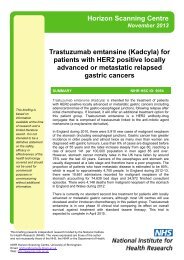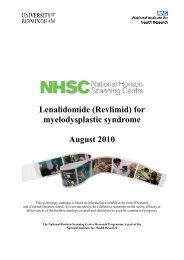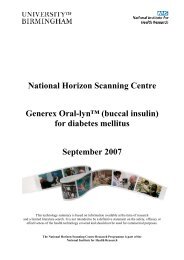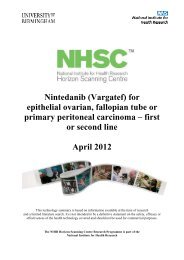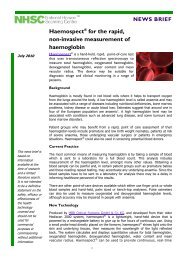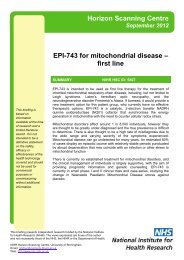Nimotuzumab (Theraloc) for glioma - National Horizon Scanning ...
Nimotuzumab (Theraloc) for glioma - National Horizon Scanning ...
Nimotuzumab (Theraloc) for glioma - National Horizon Scanning ...
Create successful ePaper yourself
Turn your PDF publications into a flip-book with our unique Google optimized e-Paper software.
<strong>National</strong><br />
<strong>Horizon</strong><br />
<strong>Scanning</strong><br />
Centre<br />
<strong>Horizon</strong> <strong>Scanning</strong> Technology<br />
Briefing<br />
<strong>Nimotuzumab</strong><br />
(<strong>Theraloc</strong>) <strong>for</strong> <strong>glioma</strong><br />
August 2006<br />
This technology briefing is based on<br />
in<strong>for</strong>mation available at the time of research<br />
and a limited literature search. It is not intended<br />
to be a definitive statement on the safety, efficacy or<br />
effectiveness of the health technology covered<br />
and should not be used <strong>for</strong> commercial purposes.
<strong>National</strong> <strong>Horizon</strong> <strong>Scanning</strong> Centre<br />
News on emerging technologies in healthcare<br />
<strong>Nimotuzumab</strong> (<strong>Theraloc</strong>) <strong>for</strong> <strong>glioma</strong><br />
Target group<br />
• In children and adolescents:<br />
o First line <strong>for</strong> diffuse intrinsic pontine <strong>glioma</strong>.<br />
o Second line <strong>for</strong> recurrent high-grade malignant <strong>glioma</strong>, including anaplastic<br />
astrocytoma (AA, grade 3), glioblastoma multi<strong>for</strong>me (GBM, grade 4) and<br />
pontine <strong>glioma</strong>.<br />
• First-line <strong>for</strong> adults with high-grade malignant <strong>glioma</strong> in combination with<br />
radiotherapy and temozolomide.<br />
Technology description<br />
<strong>Nimotuzumab</strong> (<strong>Theraloc</strong>) is an epidermal growth factor antagonist and humanised<br />
monoclonal antibody in phase III trials. <strong>Nimotuzumab</strong> is administered by a 30-minute<br />
once weekly IV infusion, <strong>for</strong> adults at a dose of 200-400 mg/m 2 and children 150<br />
mg/m 2 . <strong>Nimotuzumab</strong> has completed phase II trials <strong>for</strong> locally advanced and/or<br />
metastatic pancreatic cancer in combination with gemcitabine.<br />
Innovation and/or advantages<br />
<strong>Nimotuzumab</strong> may provide a further treatment option <strong>for</strong> high-grade <strong>glioma</strong> and the<br />
company states that it may reduce the side effects associated with other treatments.<br />
Developer<br />
YM Bioscience and Oncoscience AG (EU marketing partner).<br />
Purpose<br />
Diagnosis or identification of Investigation, assessment or<br />
disease<br />
staging of known disease<br />
Prevention e.g. immunisation, Screening programme or tests to<br />
public health programme<br />
identify latent or early disease<br />
Continuous therapy e.g. dialysis, Patient management and<br />
life support<br />
pathways of care<br />
Service delivery changes Other:<br />
Place of use<br />
Home care e.g. home dialysis<br />
Secondary care e.g. general,<br />
non-specialist hospital<br />
General public e.g. over the<br />
counter<br />
Community or residential care e.g.<br />
district nurses, physio<br />
Tertiary care e.g. highly specialist<br />
services or hospital<br />
Other:<br />
Susceptibility testing <strong>for</strong> identifying<br />
risk of disease<br />
Individual treatment e.g. drug,<br />
device, procedure, radiotherapy<br />
Rehabilitation<br />
Primary care e.g. used by GPs or<br />
practice nurses<br />
Emergency care e.g. paramedic<br />
services, trauma care<br />
Stage of development and availability in EU/UK<br />
Phase III clinical trials or<br />
Pre-registration in EU (drugs) CE marked, but not yet launched<br />
equivalent<br />
or available in UK<br />
Licence or CE mark application in Licence or CE mark application in Launch or use in UK/EU likely<br />
UK/EU likely within 12 months UK/EU likely within 24 months within 12 months<br />
Launch or use in UK/EU likely Established product, but this is a Other:<br />
within 24 months<br />
new indication in development<br />
Aug 2006 2
Orphan drug status:<br />
Orphan drug status in EU Orphan drug status in USA<br />
<strong>National</strong> <strong>Horizon</strong> <strong>Scanning</strong> Centre<br />
News on emerging technologies in healthcare<br />
NHS or Government priority area:<br />
Cancer Cardiovascular disease Children<br />
Diabetes Chronic conditions Mental health<br />
Older people Public health Renal disease<br />
Women’s health None identified Other:<br />
Relevant guidance<br />
• Improving outcomes <strong>for</strong> people with brain and other CNS tumours. NICE, June<br />
2006 1 .<br />
• Improving outcomes in children and young people with cancer. NICE, August 2005 2 .<br />
• Temozolomide <strong>for</strong> the treatment of recurrent malignant <strong>glioma</strong>. NICE, April 2001 3<br />
In progress:<br />
• Carmustine implants and temozolomide <strong>for</strong> the treatment of newly diagnosed highgrade<br />
<strong>glioma</strong>. NICE, due in March 2007 4 .<br />
Clinical need and burden of disease<br />
Malignant <strong>glioma</strong> is the most common <strong>for</strong>m of brain tumour, representing 50% to 60%<br />
of all primary brain tumours 3 . There are three main types of <strong>glioma</strong> – astrocytoma,<br />
ependymoma and oligodendro<strong>glioma</strong>. Brain tumours are graded according to their<br />
likely rate of growth, from grade 1 (slowest growing) to grade 4 (fastest growing),<br />
with grades 3 and 4 considered high-grade <strong>glioma</strong>s. Grade 3 astrocytoma is also<br />
known as anaplastic astrocytoma (AA) and grade 4 astrocytoma is also known as<br />
glioblastoma multi<strong>for</strong>me (GBM).<br />
There are about 3,550 new cases of malignant brain tumour a year in England and<br />
Wales with about 2,700 deaths 1 . Approximately 30% to 35% of malignant <strong>glioma</strong>s are<br />
AA and 40-45% are GBM 1 . An estimated 1,200 to 1,700 patients in England and<br />
Wales have AA or GBM and may be eligible <strong>for</strong> nimotuzumab. Median survival time<br />
from diagnosis <strong>for</strong> GBM is of the order of 5 to 12 months, but <strong>for</strong> AA is longer at 11<br />
to 36 months 3 .<br />
In the UK, around 400 children and adolescents are diagnosed with a brain or other<br />
central nervous system tumour each year 5 and of these, just over a third are classified<br />
as astrocytoma 6 . Fewer than 40 children a year are diagnosed with pontine <strong>glioma</strong> 7 .<br />
Children with high-grade <strong>glioma</strong> invariably have a poor outcome, with 5-year survival<br />
rates of less than 20% <strong>for</strong> AA and GBM, and median survival of only 9-12 months <strong>for</strong><br />
intrinsic brainstem <strong>glioma</strong> (including pontine <strong>glioma</strong>) 8 .<br />
Existing comparators and treatments<br />
Adults:<br />
• Surgical resection (rarely curative)<br />
• Radiotherapy<br />
• Chemotherapy e.g. temozolomide, camustine implants<br />
Children:<br />
• Surgical resection (rarely curative)<br />
Aug 2006 3
• Radiotherapy (normally in those three years or over)<br />
• Chemotherapy e.g. cyclophosphamide, vincristine<br />
Efficacy and safety<br />
<strong>National</strong> <strong>Horizon</strong> <strong>Scanning</strong> Centre<br />
News on emerging technologies in healthcare<br />
Trial name or code Children Children and<br />
young people<br />
Adults<br />
Status Abstract 9<br />
Ongoing Planned<br />
Location Germany Germany, Italy,<br />
Belarus, Russia<br />
Europe<br />
Design - randomised,<br />
controlled, uncontrolled,casecontrol,<br />
case series etc.<br />
Phase II Phase III Phase III<br />
Participants in trial – n=34<br />
number, description,<br />
trial schedule e.g.<br />
placebo or comparator<br />
a . Children with GBM, AA or<br />
intrinsic pontine <strong>glioma</strong>; progressive<br />
disease following primary or relapse<br />
treatment. Weekly infusion of<br />
nimotuzumab 150 mg/m 2 n=40. Primary Temozolomide<br />
intrinsic pontine vs. temozolomide<br />
<strong>glioma</strong><br />
plus<br />
concomitant with nimotuzumab;<br />
<strong>for</strong> 6 weeks. radiotherapy; concomitant with<br />
Patients with non-progressive disease children and radiotherapy;<br />
received 4 further infusions at 3-week<br />
intervals.<br />
adolescents. adults with GBM.<br />
Follow-up 8 and 21 weeks<br />
Primary outcome Tumour size reduction measured by MRI<br />
Secondary outcomes Clinical deterioration or improvement<br />
Key results o 12 b patients responded (1 partial<br />
response, 11 stable disease) by week 8<br />
o Median change in lesion diameter of<br />
-5% (-39 to +16%).<br />
o At 21 weeks, 5 out of 8 patients were<br />
evaluable <strong>for</strong> response after additional<br />
therapy: 3 partial responses, 1 stable<br />
disease, 1 c progressive disease. Median<br />
time free of progression was 7.5<br />
months (1.2-13.2 months) d .<br />
Expected reporting date First half 2007 Due to start in<br />
2006<br />
Major adverse effects No severe side effects<br />
Estimated cost and cost impact<br />
The cost of nimotuzumab is yet to be determined.<br />
Potential or intended impact – speculative<br />
For this technology, no barriers to diffusion within the NHS are envisaged.<br />
a 47 patients are now in the trial – company in<strong>for</strong>mation<br />
b 17 patients have now responded – company in<strong>for</strong>mation<br />
c 4 patients now have progressive disease – company in<strong>for</strong>mation<br />
d Median time free of progression is now 9.1 (censored) months (1.2 – 20.5 months) – company in<strong>for</strong>mation<br />
Aug 2006 4
Patients<br />
Reduced morbidity Reduced mortality or increased<br />
Quicker or more accurate<br />
diagnosis<br />
Services<br />
Increased use e.g. length of stay,<br />
out-patient visits<br />
Decreased use e.g. shorter length of stay, reduced<br />
referrals<br />
Costs<br />
Increased unit cost compared to<br />
alternative<br />
Savings:<br />
Unknown:<br />
References<br />
<strong>National</strong> <strong>Horizon</strong> <strong>Scanning</strong> Centre<br />
News on emerging technologies in healthcare<br />
Improved quality of life <strong>for</strong> patients<br />
survival<br />
and/or carers<br />
Earlier identification of disease Changed pathway of care or<br />
outcome<br />
Service reorganisation required Staff or training required<br />
Increased costs: more patients<br />
coming <strong>for</strong> treatment<br />
Increased costs: capital<br />
investment needed<br />
1 Improving Outcomes <strong>for</strong> people with brain and other CNS Tumours, <strong>National</strong> Institute <strong>for</strong> Health and Clinical<br />
Excellence. The Manual. June 2006<br />
2 Improving outcomes in children and young people with cancer, <strong>National</strong> Institute <strong>for</strong> Health and Clinical<br />
Excellence. The Manual. August 2005<br />
3 Temozolomide <strong>for</strong> the treatment of recurrent malignant <strong>glioma</strong> (brain cancer), <strong>National</strong> Institute <strong>for</strong> Health and<br />
Clinical Excellence. Number 23, April 2001.<br />
4 Final Appraisal Determination: Glioma (newly diagnosed and high grade) - Carmustine implants and<br />
temozolomide, <strong>National</strong> Institute <strong>for</strong> Health and Clinical Excellence, April 2006<br />
5 Cancer Research UK, data <strong>for</strong> 2002, http://info.cancerresearchuk.org/cancerstats/types/brain/incidence<br />
(accessed 6/7/2006)<br />
6 Cancer Research UK, http://info.cancerresearchuk.org/cancerstats/childhoodcancer/incidence/#brain (accessed<br />
6/7/2006)<br />
7 The Royal Marsden NHS Foundation,<br />
http://www.royalmarsden.nhs.uk/RMH/cancer/paediatriccancers/pontine<strong>glioma</strong>/?wbc_purpose=Basic<br />
(accessed 5/7/06)<br />
8 The Institute of Cancer Research.<br />
http://www.icr.ac.uk/research/research_sections/paediatric_oncology/paediatric_oncology_teams/molecular_pa<br />
thology/<strong>glioma</strong>s/index.shtml (accessed 6/07/2006)<br />
9 Bode U, Buchen S, Janssen G et al., Results of a phase II trial of h-R3 monoclonoal antibody (nimotuzumab) in<br />
the treatment of resistant or relapsed high-grade <strong>glioma</strong>s in children and adolescents. American Society of<br />
Clinical Oncology, 2006, abstract no. 1522<br />
The <strong>National</strong> <strong>Horizon</strong> <strong>Scanning</strong> Centre is funded by the Research and Development Division<br />
of the Department of Health, England<br />
The <strong>National</strong> <strong>Horizon</strong> <strong>Scanning</strong> Centre,<br />
Department of Public Health and Epidemiology<br />
University of Birmingham, Edgbaston, Birmingham, B15 2TT, England<br />
Tel: +44 (0)121 414 7831 Fax +44 (0)121 414 2269<br />
www.pcpoh.bham.ac.uk/publichealth/horizon<br />
Aug 2006 5



